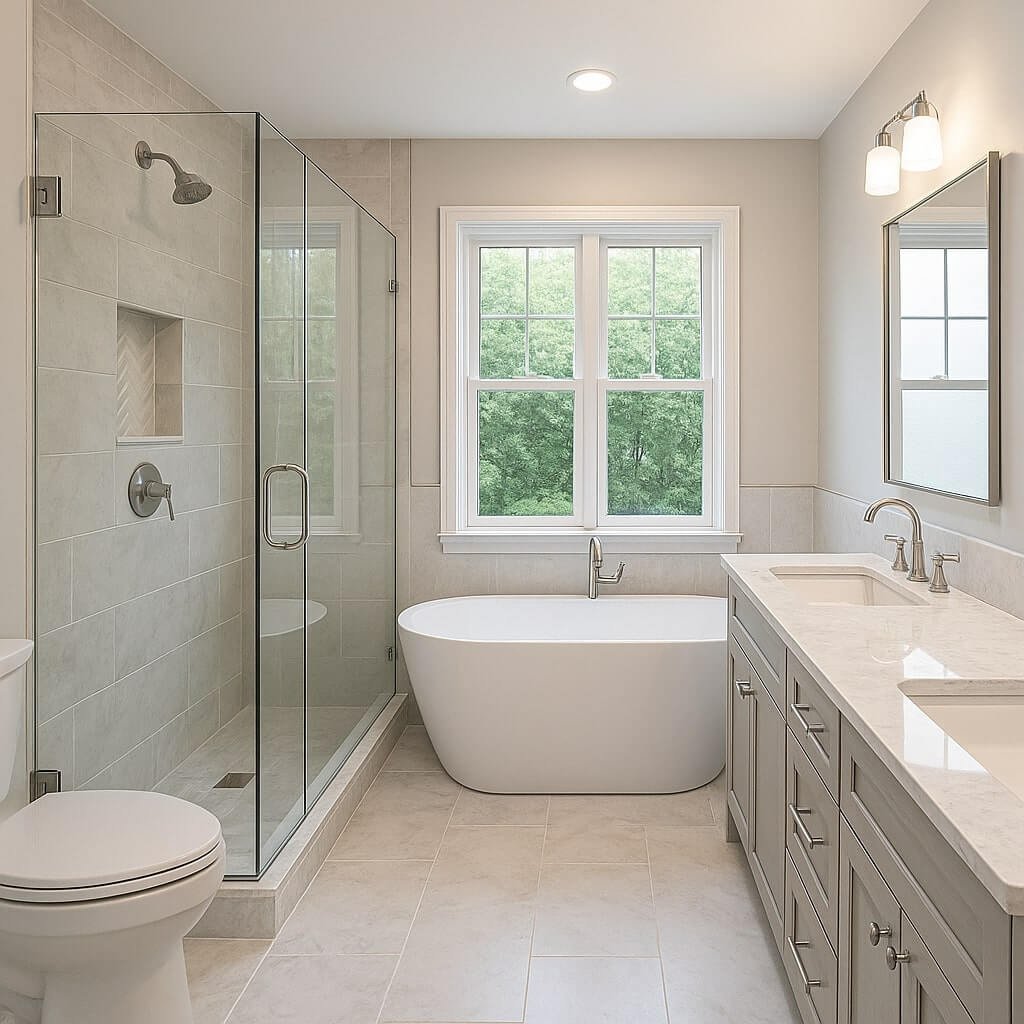As more homeowners choose to age in place, remodeling the bathroom becomes a top priority. A well-designed aging-in-place bathroom boosts safety, accessibility, and independence—all while maintaining style. Whether you’re planning ahead or making urgent updates for a loved one, this guide will help you understand how to create a bathroom that’s both functional and future-proof.
Why Aging in Place Bathroom Remodeling Matters
Bathrooms pose significant safety risks due to slippery surfaces, tight spaces, and low lighting. For seniors or those with mobility challenges, standard bathrooms can quickly become hazardous. A strategic remodel enhances:
- Safety: Reduces slip-and-fall risks.
- Mobility: Supports movement with grab bars, walk-in tubs, and barrier-free showers.
- Independence: Allows users to bathe and use the restroom without assistance.
- Peace of Mind: Gives family members confidence in their loved one’s well-being.
Key Aging in Place Bathroom Features
1. Walk-In or Curbless Showers
A no-threshold shower eliminates tripping hazards and makes it easy for wheelchairs or walkers to enter. Pair it with a slip-resistant floor and a hand-held showerhead for versatility.
2. Grab Bars and Reinforced Walls
Install sturdy grab bars near the toilet, inside the shower, and along the bathroom walls. These are essential for stability and can prevent dangerous falls. Be sure the walls are reinforced to support them properly.
3. Comfort-Height Toilets
Standard toilets can be too low, making it difficult for seniors to sit or rise. Comfort-height toilets are slightly taller and ergonomically designed for ease of use.
4. Non-Slip Flooring
Choose materials like textured porcelain tile, rubber flooring, or luxury vinyl that minimize slipping, especially when wet.
5. Improved Lighting
Install bright, shadow-free lighting around the vanity, shower, and toilet areas. Motion-sensor lights or nightlights are ideal for late-night visits.
6. Accessible Vanity and Sink
Opt for a floating vanity or open knee space to allow wheelchair access. Leverage single-handle or touchless faucets to accommodate limited dexterity.
7. Walk-In Bathtubs
Though more costly, walk-in tubs are great for those who enjoy soaking but need safer access than traditional bathtubs provide.
Planning the Remodel: Expert Tips
Hire Certified Aging in Place Specialists (CAPS)
Working with a CAPS-certified contractor ensures your remodel meets both safety standards and practical needs.
Think Long-Term
Even if mobility is not currently an issue, planning can save time and money. Include adaptable features that can grow with the homeowner’s needs.
Prioritize Accessibility First
Always begin with layout changes, then focus on fixtures. A clear, wide pathway for walkers or wheelchairs should guide your design.
Estimated Costs of an Aging in Place Bathroom Remodel
| Feature | Average Cost Range |
|---|---|
| Walk-in shower | $2,500 – $7,000 |
| Grab bar installation | $200 – $500 |
| Comfort-height toilet | $300 – $800 |
| Walk-in tub | $3,000 – $10,000 |
| Slip-resistant flooring | $800 – $2,500 |
| Lighting upgrades | $150 – $1,200 |
Keep in mind that prices may vary based on materials, labor, and location.
Benefits of Aging in Place Bathroom Upgrades
- Promotes Independence: Allows seniors to use the bathroom with dignity.
- Reduces Hospital Visits: Fewer falls lead to fewer medical emergencies.
- Adds Home Value: A safe, accessible bathroom is attractive to future buyers.
- Supports Caregivers: Easier for caregivers to assist when needed.
Frequently Asked Questions (FAQs)
What is the most important bathroom upgrade for aging in place?
The walk-in shower or barrier-free shower is arguably the most crucial upgrade due to its ability to reduce falls and accommodate mobility aids.
Are aging-in-place upgrades covered by Medicare?
Generally, Medicare does not cover home modifications. However, Medicaid and some state or local programs may offer financial assistance.
How wide should doorways be in an accessible bathroom?
Ideally, doorways should be at least 36 inches wide to accommodate wheelchairs or walkers.
Can I remodel my bathroom in stages?
Yes, many homeowners choose to upgrade in phases, starting with safety features like grab bars and flooring, then moving to fixtures like tubs and vanities.
Does an aging-in-place bathroom look clinical?
Not at all! With today’s design innovations, safety features can be stylish. You can blend modern finishes with accessibility for a functional and elegant space.
Final Thoughts: Design for Safety, Live with Comfort
Remodeling your bathroom for aging in place is not just a wise investment—it’s a compassionate decision. By prioritizing accessibility, safety, and long-term usability, you create a haven that empowers independence and protects loved ones. Whether you’re updating a family home or future-proofing your living space, these upgrades ensure your bathroom remains a safe and comfortable part of the home for years to come.




